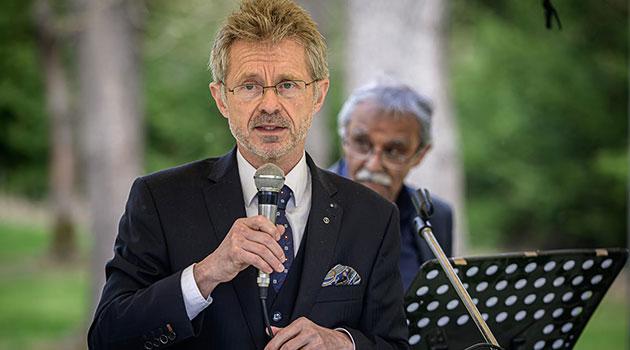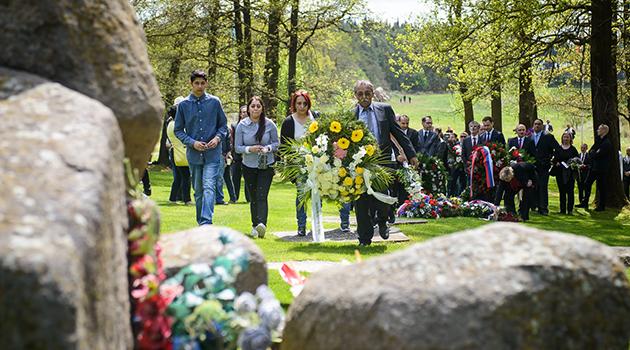President of Czech Senate says Lety commemorations are a call for people to treat minorities fairly

The memorial at the site of the WWII-era concentration camp for Romani people at Lety u Písku is a call for society to treat all minorities fairly in the future, the President of the Czech Senate, Miloš Vystrčil (Civic Democratic Party – ODS) told the Czech News Service (ČTK) yesterday. The commemorative gathering started at noon yesterday to honor the memory of the Jewish and Romani victims of Nazism at the site of what was once the burial ground for some of those who died in the camp.
Čeněk Růžička from the Committee for the Redress of the Roma Holocaust (VPORH) said that the respect shown during the commemoration is deserved by all victims of Nazism. Czech Culture Minister Martin Baxa (ODS) described the pig farm as a place of Czech shame and apologized for politicians of various parties who previously disregarded or ignored this dark story.
Today’s commemoration is also important because the situation of minorities is becoming increasingly tense in the Czech Republic in the runup to the municipal elections, Deputy Prime Minister Ivan Bartoš (Pirates) told ČTK. According to the Museum of Romani Culture, the demolition of the buildings belonging to the pig farm that was built over the concentration camp site should start in the summer.
“Places of reverence document the injustice and fierce persecution that the Romani community, the Jewish community and other people experienced from the Fascists. They are a reminder to us to do everything that is possible to prevent such suffering. The fact that we are commemorating the places where this happened amplifies the call to do all we can to make sure society manages to behave fairly and seriously toward minorities, whether they are ethnic, social or religious, and to realize on the one hand that the level of a democratic society can be measured according to how minorities are treated and, on the other hand, according to whether that society can admit its mistakes or not,” Vystrčil told ČTK.
The senator went on to say that all this is symbolized by the Lety u Písku memorial. It documents how neither the Fascists nor the Communists tolerated minorities.
“We, too, made a mistake when we did not manage to buy out the pig farm in a timely way and to build a memorial here. Once we realize the great importance of this place of reverence, it took longer than it should have,” Vystrčil said.
The commemorative ceremony was also attended by Deputy Prime Minister Ivan Bartoš (Pirates), Czech Culture Minister Baxa, and former Foreign Minister Karel Schwarzenberg (TOP 09). Baxa said the Roma have experienced segregation and social exclusion for centuries.
“Most Czech Roma met a tragic fate in the Holocaust. Their social segregation continued in a different form under communism. I wish I could say the story of Romani exclusion ended with November 1989, but it took more than 20 years after the revolution for the decision to be made to buy out the pig farm,” Baxa said.
Bartoš told ČTK that the commemorative ceremony is appropriate at Lety because history tends to repeat itself. “For example, the situation that is related to the current war and its refugees in some respect is copying the history of World War II. The Lety memorial that will soon stand is evidence of human endurance, of the people who do not forget. Memory and dignified remembrance allows us to avoid those same mistakes. The situation with a view to the municipal elections and minorities in the Czech Republic is becoming acute again. We must find our humanity in ourselves, not our prejudices,” Bartoš said.
Christian Democratic (KDU-CSL) MP Hayato Okamura said that, just as it was 80 years ago, the issue is about humanity. “[We must] overcome this sense of foreignness, of otherness, anonymity among people. The events in Ukraine show us that our seemingly everyday humanity is not a self-evident value,” he said.
The lawmaker added that it is necessary to prevent the populism of those who “play the Roma card” in the municipal and other elections. After the ceremony, those attending were also able to visit the parish cemetery in the nearby village of Mirovice, where primarily the child victims of the concentration camp at Lety were buried in a mass grave.
The commemorative ceremony began with the Czech national anthem and a minute of silence for the victims of the war in Ukraine. “The Holocaust of the Roma is still an unknown concept, to a big extent. Something about it is already known in society, but society still has not learned the lessons of the Holocaust of the Roma, and that makes me very angry. We are doing our best to inform society in a reasonable way,” Růžička told ČTK.
According to the VPORH chair, there is still not enough money raised for what he called “the most important” aspect of the commemoration project still in development, the Centre for the Roma and Sinti in Prague. The establishers received approximately CZK 30 million [EUR 1.2 million] from Norway Grants for it, Růžička said.
From the history of the concentration camp at Lety u Písku
At Lety u Písku in the Protectorate of Bohemia and Moravia (16 March 1939 – 8 May 1945), the area where the concentration camp would one day exist originally served in 1940 as an accommodation facility for construction workers. It then became a disciplinary labor camp upon the order of Interior Minister Josef Ježek, on 15 July 1940, issued on the basis of Czechoslovak Government Decree No. 72 on disciplinary labor camps, dated 2 March 1939.
The disciplinary labor camp decree had been issued before Czechoslovakia was occupied by the Nazis. It stipulated that the persons who were to be concentrated in disciplinary labor camps were “able-bodied wandering gypsies and other vagabonds living that same way, beggars by occupation and people who make their livings from the begging of others (children, etc.), professional gamblers, notorious bums, good-for-nothings and people who make their livings from dishonest earnings (prostitution, etc.), either their own or that of others.”
The first 20 prisoners arrived at the disciplinary labor camp at Lety on 17 July 1940. On 1 August 1942, it was transformed into a “Gypsy Camp”, after which entire families of Romani people were transported there.
The concentration camp at Lety began operations on 1 August 1942 and ceased operations on 4 May 1943. Its capacity was enlarged to accommodate up to 600 prisoners, but even that number was soon exceeded, because during August 1942 more than 1 100 children, men and women were imprisoned there.
The camp was not equipped with the necessary hygienic and other facilities for such a large number of people. The prisoners frequently had to bathe in a nearby fishpond.
Prior to August 1942, the camp had just been used to house male prisoners. As of August 1942, children and women were also brought there to rot in absolutely appalling conditions.
After the big intake of prisoners in August 1942, most of the rest just arrived at the camp as families or individuals. A total of 326 people died on the concentration camp grounds at Lety, of whom 241 were children.
An improvised burial ground was dug near the camp for 120 of the victims. However, some survivors say many more prisoners than that perished in the camp.
During their transport to Auschwitz, another 540 Lety prisoners died on the way. There were two mass transports to Auschwitz from Lety.
The first was on 3 December 1942, a transport of those called “asocials”, 16 men and 78 women, who were forcibly sent to the Auschwitz I Concentration Camp. The second transport, for all practical purposes, meant the camp at Lety was no more, because 417 prisoners were forcibly sent to the Auschwitz II-Birkenau Concentraion Camp.
The first transport from Lety u Písku to Auschwitz was undertaken on the basis of a crime prevention decree, but the second was undertaken on the basis of a decree handed down by Reichsführer of the Schutzstaffel (Protection Squadron – SS) Heinrich Himmler on 16 December 1942, which ordered all Romani people transported to the Auschwitz Concentration Camp. The remaining 198 prisoners were moved to the “Gypsy Camp” at Hodonín u Kunštátu (called Žalov) or to detention camps in Pardubice and Prague.
